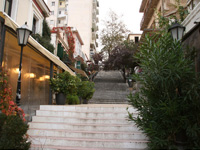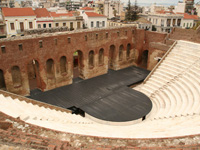|
The
bulky white boats wallow at the docks. Their bellies
swell with tourists, lured by exotic dreams, the
siren songs of Captain Corelli in Cephalonia and
la dolce vita in Italy. To most travelers, Patras
is a dim station, a smear of ticket booths and
cheap cafes, a grungy working port. A place endured
en-route to somewhere better, somewhere more exciting.
But Patras is emerging from the long shadows of
the sirens it serves. Greece's third-largest city
has blossomed into a sophisticated center, adorned
with leafy arcades, vibrant squares and neoclassical
architecture.
 |
Cafes, tavernas and bars sprawl into the broad
streets. Business is brisk. Boutiques gleam on
every corner, peddling chic clothing, petite cell
phones and dazzling chrome gadgets. Everyone's
there - islanders, farmers, shy mountain villagers
- all intoxicated by the quick rhythm of Patras,
the city at the crossroads, the provincial capital
on the rise.
Small wonder the European Union is honoring this
hotspot in 2006. Patras is the third Greek Capital
of Culture, following in the footsteps of Athens
and Thessalonica. The scheme - inspired by Hellenic
muse Melina Mercouri, the late actress and activist
- will sponsor events ranging from classical drama
to graffiti exhibitions.
High
jinx and high spirits
Patras' renown is partly due to its carnival.
One of the world's largest after Venice and Rio
de Janeiro, it attracts around half a million
people mid-January to mid-March. The Treasure
Hunt remains a highlight: hundred-strong teams
- many with goofy names like "Blue Flames"
or "Golf Sexperience" - comb the city
for hidden prizes. Ash-smeared revelers (boules)
also stage a mock wedding, satirizing Giannoula
Koulourou, who believed she would wed a U.S. President
between the World Wars.
Balls and concerts abound, along with a confetti
fight and "chocolate war." Karnavalos,
the king puppet, leads the final, wild procession
on the day before Orthodox Lent. After a solemn
farewell, he is burnt on Agios Nikolaos Pier,
as fireworks ignite the sky and dark gulf.
Historic city
The "nymph of the Patrasikos" lies on the northern coast of the Peloponnesus, close to the ancient sites of Delphi, Epidaurus and Olympia. Settled around 1100 BC, this rich coastal area fell to the Romans a millennium later.
The first apostle, Andrew, introduced Christianity to Greece there. The Emperor Nero martyred him where the cathedral now stands. A dozen small cupolas surround the 43-meter main dome, representing Jesus and the apostles. Finished in 1974, St Andrew's houses up to 8,000 worshippers.
Archaeology buffs delight in the Roman Odeon, the most important of its kind after Athens' Theater of Herod Atticus. Reconstructed and swathed in marble, it still hosts summer performances.
 |
Patras' castle dominates the hillside nearby. The massive fortress - built in the sixth century over the ancient acropolis - was used continuously until World War II. The site is now a rambling, shady park with views of Zante and Cephalonia on a clear day. A wild swathe - known as dasyllio, the small forest - stretches west of the castle. To the east lies Plateia Psila Alonia, the "balcony of Patras". Locals gather there, by the palms and splashing fountain, to sip strong coffee, watching the world pass in the port below.
Intrepid travelers venture farther uphill to the Achaia Clauss winery, where sweet, purple Mavrodaphne is made. Gustav Clauss, a Bavarian, founded the wine estate in 1861. The stout walls and towers were not for show, but to ward off bandit attacks. Now Clauss' blends are more likely to attract celebrities than brigands, however. Franz Liszt, Aristotle Onassis and Margaret Thatcher all visited the "imperial cellar", home to 128 rare barrels worth millions of euros.
The winery is an unexpected gem, much like the city itself. Forbidding at first glance, both yield up sophisticated luxuries on closer inspection.
Patras will never distract from its sirens - Italy and the Ionian Islands. But perhaps tourists might learn to pause, look outside the porthole and give this neglected nymph a chance to shine.
If You Go: |
Patras is a smooth, pleasant drive from Athens, along the coastal E65 highway (210km/130mi). Greece's second-largest port services the Ionian Islands and Italian destinations, such as Brindisi, Ancona, Bari and Venice.
Climb the 193 steps crowning Agiou Nikolaou to Patras' castle (2610-623390; closed Monday). The Roman Odeon lies on the corner of Germanou and Sothriadou Streets (2610-220829; closed Monday). Visit the Achaia Clauss Winery, a ten-minute drive outside town on Patron-Clauss Avenue (2610-368100).
Learn more about European Capital of Culture festivities at www.Patras2006.gr and the carnival on www.carnivalPatrass.gr. The tourism office is near the docks (2610-461740; www.infocenterpatras.gr).
|
|